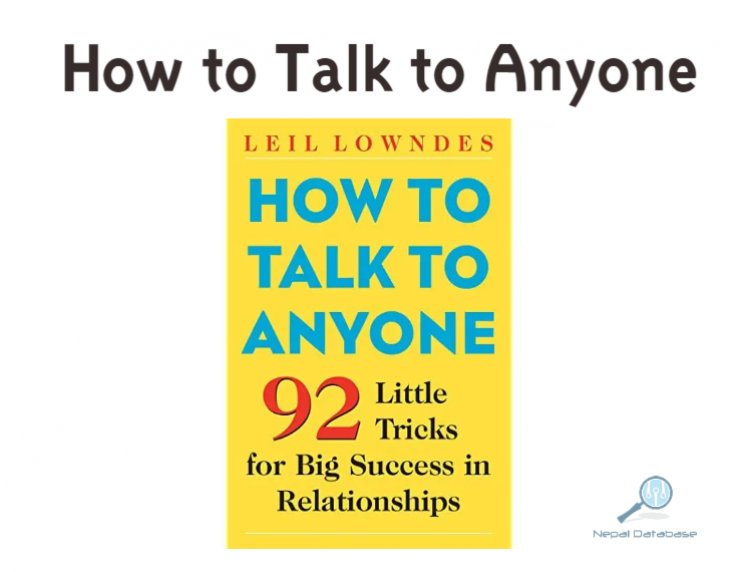20 learnings from How to Talk to Anyone
How to Talk to Anyone provides tips and strategies for improving communication skills and building relationships with others. Here are some key learnings from the books.

"How to Talk to Anyone" is a book by Leil Lowndes that provides tips and strategies for improving communication skills and building relationships with others. Here are some key takeaways from the book:
- Make a good first impression: First impressions are important and can set the tone for future interactions. To make a good first impression, smile, make eye contact, and use a firm handshake.
- Show genuine interest in others: People appreciate when you show interest in them and their lives. Ask questions and listen attentively to show that you care.
- Use positive body language: Nonverbal cues, such as eye contact and posture, can communicate a lot about how you feel and what you think. Use positive body language, such as maintaining eye contact, to show that you are engaged and interested in the conversation.
- Use the other person's name: Using someone's name can help to personalize the conversation and make the other person feel valued.
- Be a good listener: Being a good listener means paying attention to what the other person is saying and responding thoughtfully. Avoid interrupting and try to understand the other person's perspective.
- Practice small talk: Small talk can help to build rapport and establish a connection with others. Practice making small talk by finding common ground, such as shared interests or experiences.
- Use open-ended questions: Open-ended questions encourage the other person to share more information and can help to foster a deeper conversation.
- Avoid controversial topics: To avoid causing tension or discomfort, it is generally best to avoid discussing controversial topics, especially if you do not know the other person well.
- Be mindful of your tone: Your tone of voice can have a big impact on the way your message is received. Be mindful of your tone and try to use a friendly, respectful, and positive tone.
- Use positive language: Using positive language can help to create a more positive and welcoming atmosphere. Instead of focusing on negative aspects, try to find the positive in any situation and express it.
- Be authentic: Being authentic means being genuine and true to yourself. Being authentic can help to build trust and establish deeper connections with others.
- Practice empathy: Empathy means being able to understand and share the feelings of others. By practicing empathy, you can build stronger relationships and improve your communication skills.
- Be confident: Confidence can help you feel more comfortable in social situations and can make you more approachable to others.
- Use humor: Humor can help to lighten the mood and make conversations more enjoyable. However, be mindful of the other person's sense of humor and avoid telling jokes that may be offensive or inappropriate.
- Show gratitude: Expressing gratitude can help to build positive relationships and show that you value the other person's time and effort.
- Avoid judgment: Try to avoid judging or criticizing others, as this can create tension and damage relationships. Instead, try to be understanding and open-minded.
- Be present: When you are in a conversation, try to be fully present and focused on the other person. Avoid distractions such as checking your phone or multitasking.
- Be flexible: Be open to different perspectives and be willing to adjust your communication style to better suit the needs and preferences of the other person.
- Practice active listening: Active listening involves paying attention to what the other person is saying, asking clarifying questions, and providing feedback to show that you are understanding and engaged in the conversation.
- Use nonverbal cues: Nonverbal cues, such as facial expressions, gestures, and eye contact, can communicate a lot about how you feel and what you think. Pay attention to your own nonverbal cues and try to use them to show that you are interested and engaged in the conversation.
In conclusion, there are many ways to improve your communication skills and build relationships with others. Some key tips include making a good first impression, showing genuine interest in others, using positive body language, using the other person's name, being a good listener, practicing small talk, using open-ended questions, avoiding controversial topics, being mindful of your tone, using positive language, being authentic, practicing empathy, being confident, using humor appropriately, showing gratitude, avoiding judgment, being present, and being flexible. By following these tips and practicing good communication skills, you can build stronger, more meaningful relationships with others.
What's Your Reaction?




































































































